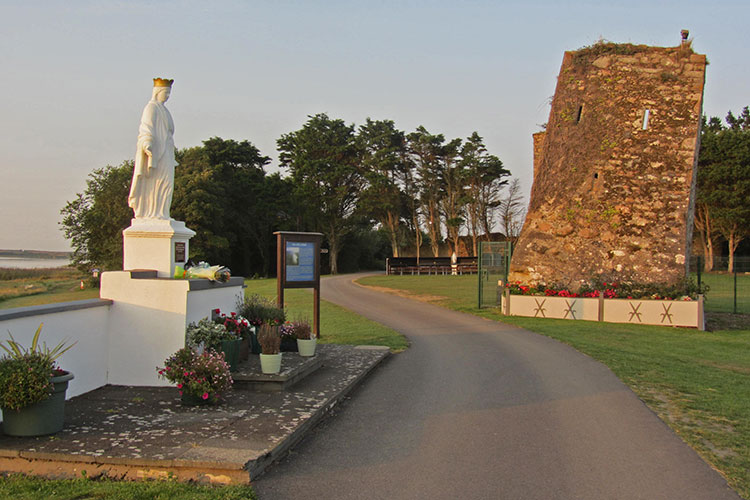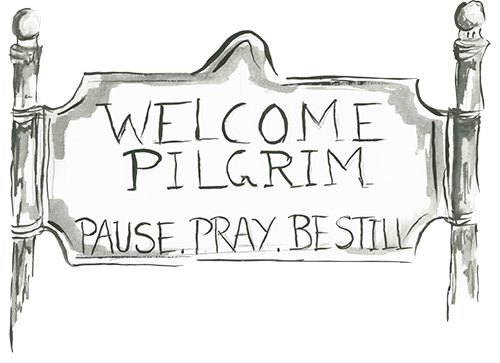OVERVIEW
This stage takes you through an area of Wexford that is rich with echoes from the Norman Conquest of Ireland. One such bequest was the Yola Language, a form of old English that was carried to Wexford by the Norman invaders and spoken in this area for hundreds of years. The Yola language became extinct with the last native speaker dying in 1998, but many words and phrases still survive in the locality.
Of note along the way, and just off the route is the village of Tacumshane which is worth a visit to see the old windmill and nearby Bullaun Stone (about 100m west of the windmill). Constructed from timber washed ashore on nearby beaches, it is the only fully complete windmill of its kind surviving in Ireland. A rare feature is its revolving straw thatched cap to catch the wind for its sails. A Bullaun Stone is one with a depression carved into it and is an example of early Christian past in this area.
The main highlight of this stage is the end at Our Lady’s Island – make sure that you allow plenty of time to explore this renowned pilgrimage destination. Whilst named an island it is actually on a lake peninsula, housing an impressive Norman castle and tower along with the remains of a medieval church and graveyard (see further information in the highlight below).
HIGHLIGHTS / PLACES OF INTEREST
Tacumshane Windmill
This traditional windmill is thought to have been the oldest commercially working windmill in the Republic. The millwright Nicolas Moran, who trained in Rotterdam, built the mill in 1846 and it seems to have stopped being used sometime before 1930.
Apparently most of the timber was salvaged from the coast being either driftwood or timber from shipwrecks. There were 13 such corn mills in the coastal region of which Tacumshane is the last. It is now a National Monument.
There is something very special about seeing this old structure, a reminder of work on the land through the ages – a connection between earth and sky. In the 21st Century, we are still trying to harness the wind for a climate solution but the modern metal-built windmills have nothing of the elegance evident here.
Our Lady's Island
Here you will discover a magical location. It has been a place of Christian pilgrimage for at least 1,500 years, but the sacredness of the location pre-dates Christianity as a place of pagan worship. In pre-Christian times, it was known as the Meadow of the Women in honour of the female druids who lived there before Christianity arrived. The importance of female worship was not lost on the early church though and they absorbed this tradition by renaming it Our Lady’s Island after the mother of Jesus, so that people could continue to venerate female spirituality.
Since then, it has been an important shrine for Marian worship. The site, which is located not on an island but on a lake peninsula, contains an impressive Norman castle and tower, along with the remains of a medieval church and graveyard.

Pilgrims on the road

Entering Our Lady's Island

Our Lady's Island

Church of the Assumption

Fr Jim Cogley

Our Lady's Well

Sign to Our Lady's Well

Tacumshane Windmill
Photo Credit - Creative Commons/Mike Searle

Celtic Cross
Oliver Cromwell and Our Lady’s Island

In October 1649, the arrival of Oliver Cromwell in Wexford created fear among the native population with many people seeking sanctuary on Our Lady’s Island. As also happened on the Rock of Cashel, Co Tipperary, Cromwell’s soldiers did not recognise the sanctuary of a church. Many of those seeking refuge were murdered and the church was desecrated and unroofed.
During the massacre, a local man rushed into the church and snatched from the altar the crucifix that was venerated by generations of pilgrims. In a bid to save it from the English soldiers he attempted to escape across the lake. He was, however, shot and the crucifix was lost. It remained on the lake bed until 1887 when it was found and taken to the local parish priest. Today, it is preserved in a simple shrine in the parish church.

MUMMING
Another still vibrant tradition in South Wexford is that of mumming, which it is generally accepted was brought to Wexford by the Normans. Traditionally, mummers go from house to house and perform music and short plays, with most of the characters drawn from Irish history. They wear special costumes and straw masks and are given food or money as a token of gratitude. Led by a “Captain” who proclaims their arrival and asks for permission to perform, they carry wooden swords which then become part of an intricate dance.
Image credit: Thanks to Sean Rowe for image of Drinagh Mummers
Sign up for our Newsletter
Be the first to know about guided events being offered along the route and all the latest developments as we head for a pilgrimage launch in 2023.

